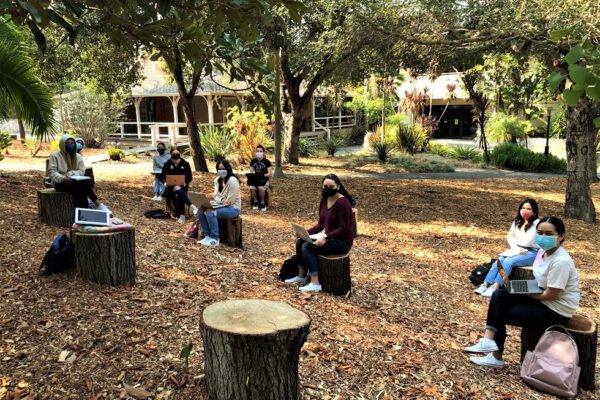By Morgan Taylor
Minority serving institutions (MSIs) serve an important role in higher education—and in the lives of millions of students of color and students from low-income backgrounds. The U.S. Department of Education’s eligibility matrix currently flags over 700 institutions as eligible to apply for federal MSI designation and funding under Title III and Title V of the Higher Education Opportunity Act.
As the postsecondary student body continues to diversify, the number of MSIs will continue to increase. This is particularly true for the MSI types predicated on an institution reaching a defined enrollment threshold. For example, legislation stipulates, among other requirements, institutions have an undergraduate student body that is at least 25 percent full-time equivalent Latino for federal designation as a Hispanic-Serving Institution (HSI).
Upward Mobility
The Equality of Opportunity Project (EOP), led by Raj Chetty, John Friedman, and Nathaniel Hendren, recently unveiled a robust dataset that combines data from the Department of Education and de-identified data from income tax returns. The EOP uses these data to research education, neighborhoods, and health as a way to inform and develop scalable policies that can “empower families to rise of out poverty and achieve better life outcomes.”
The work by Chetty and his colleagues is transformative in that it sheds a light on intergenerational mobility in ways that have never been done before. Namely, these data allow us to see income mobility between generations through the comparison of parental and child income tax returns. These data also provide a picture of the various factors that affect which individuals move up the economic ladder.
Two key pieces of research in particular stand out among the EOP’s portfolio of work. The first, a report titled Race and Economic Opportunity in the United States: An Intergenerational Perspective, provides a glimpse into the role an individual’s race plays in his or her ability to achieve the American dream. The findings show racial disparities in intergenerational mobility between black and white children, where blacks have higher rates of downward mobility than whites. These disparities are largely due to drastic differences in outcomes for black and white men who have similar family backgrounds, live in the same neighborhood, and go to the same school.

The second report, Mobility Report Cards: The Role of Colleges in Intergenerational Mobility, is integral to our understanding of how a college education can contribute to the upward income mobility of millions of students. Analyzing the mobility rate of individual institutions, Chetty and his colleagues found that mobility varies widely across higher education depending on where students enroll and their success once they enter into adulthood. Institutions with the largest mobility rates—those with potential of being “engines of upward mobility”—enroll a large percentage of low-income students who then experience high levels of success as adults.
Using this work as a backdrop, a new report by ACE’s Center for Policy Research and Strategy, Minority Serving Institutions as Engines of Upward Mobility, uses EOP data to analyze upward income mobility at MSIs compared to non-MSIs. The report describes the contributions of MSIs to intergenerational mobility for four MSI types: Historically Black Colleges and Universities (HBCUs), Hispanic-Serving Institutions (HSIs), Predominantly Black Institutions (PBIs), and Asian American and Native American Pacific Islander-Serving Institutions (AANAPISIs).
Understanding the Data
Before we dive into the report’s findings, let’s take a minute to talk data. The report looks at mobility rates of MSIs and non-MSIs. As Chetty defines it, mobility rate is the product of an institution’s access rate multiplied by its success rate.
What does this mean? The mobility rate takes the proportion of an institution’s students who come from families in the bottom quintile of the income distribution (the lowest-income students) and multiplies that by the proportion of these lowest-income students, who by age 30, moved to the top quintile of the income distribution.
Let’s now use a concrete example to add context:
- If 15 percent of students within a given cohort at institution A are from the lowest income quintile and 10 percent of those students move to the top income quintile as adults, the institution would have a mobility rate of 1.5 percent (15% x 10% = 1.5%).
- If 40 percent of students within a given cohort at institution B are from the lowest income quintile and 10 percent of those students move to the top income quintile as adults, the institution would have a mobility rate of 4 percent (40% x 10% = 4%).
- This would mean that even though the two institutions have the same percentage of lowest-income students who move up to the top income quintile (10 percent), institution B has a higher mobility rate because it is moving a larger proportion of students up (this is because it enrolls 40 percent low-income students, compared to 15 percent at institution A).
In reading the data, one should think of mobility rates as an institutional measure, not a student-level measure.
MSIs as Engines of Upward Mobility
Those who study MSIs understand firsthand that these institutions are doing more with less. As the data in this report show, most MSIs have fewer expenses per full-time equivalent with which to serve their students. Overall, they are also serving a larger percent of low-income and first-generation students than their non-MSI counterparts. For example, one in five students at four-year HSIs and nearly one in four students at four-year PBIs and HBCUs were from families in the lowest income quintile. These numbers are more than three times that of four-year non-MSIs.
Turning to upward income mobility, we found that across the board, MSIs propel their lowest-income students to the top income quintile at rates similar to—and in many cases, rates exceeding that of—non-MSIs. For example, the mobility rate of four-year HSIs was three times that of non-MSIs (4.3 percent compared to 1.5 percent). The mobility rate of AANAPISIs, PBIs, and HBCUs was double that of non-MSIs.
Our analysis also sought to provide a wider lens through which to look at intergenerational mobility at MSIs. By creating an extended mobility rate, we measured the rate at which students who come from families in the bottom two income quintiles end up in the top two income quintiles as adults. Across MSIs types, we found that MSIs had higher extended mobility rates than non-MSIs.
MSI scholars, advocacy groups, and students have often championed the academic and non-academic benefits of attending an MSI. However, until recently we have had limited quantitative data to show how MSIs contribute to the upward mobility of their students. As the student body continues to diversify, institutions and higher education more broadly should look to MSIs as examples of how to effectively serve today’s student body.
MSIs largely enroll a student body that fits the definition of post-traditional students—those who are over the age of 25, are financially independent, work full time, or have connections to the military. In addition, federal legislation requires that enrollment-based MSIs have a student body where at least half receive need-based assistance and that a substantial portion of students receive Pell Grants. As a result, MSIs enroll the very type of student who stands to gain the most from a postsecondary education as an avenue to moving up the economic ladder.
Research shows that MSIs perform better than the federal graduation rate suggests. Leading to this success is the fact that MSIs meet their students where they are, serving them in exemplary ways. As the findings in the report show, MSIs do well by their students even under financial constraints. However, imagine what they could do with more. Additional funding to Titles III and V invests not only in the capacity of MSIs, but also in the success of the millions of students of color and low-income students they serve.
To review the full analysis, download the report here.
If you have any questions or comments about this blog post, please contact us.


